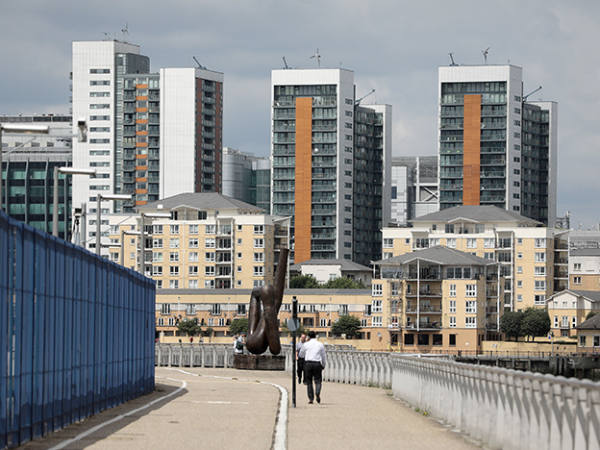- The large housebuilders build most newbuild stock
- But they face a lot of criticism for their practices
Few business models are as political as housebuilding. The homeownership dream is a core part of British conservativism; 1.5mn new homes was the cornerstone pledge of Labour leader Keir Starmer’s conference speech last month; and debate over the blocking or backing of housebuilding in a given area often forms the bedrock of local politics. The topic also looks set to play an important role in the coming general election, with pollster YouGov ranking it as the most important voter issue bar only the economy.
Housebuilders claim to dislike being a political football, but they also embrace aspects of that position. All of the major players and their lobby groups – such as the Home Builders Federation (HBF) – campaign for fewer planning restrictions, looser building standards, and demand incentives for buyers. Housing developers also like to pitch their business to investors as the solution to a UK housing landscape often characterised by a limited, unaffordable, and low-quality stock of homes.
But are they right to describe themselves in that way? And how does having a business model so central to the political debate affect them?
Bulk sales bump shares
Whether or not housebuilders or build-to-rent (BTR) developers are solving the housing crisis, it is clear that investors are willing to put money behind those who claim they are – or, at least, that companies are increasingly describing their new business wins in these terms. Earlier this month, Springfield's (SPR) share price sprang 7 per cent on the morning the Scottish Aim-listed housebuilder revealed it had signed a £6mn contract to build council homes for Highland Council in north-west Scotland.
This investor excitement came two months after Vistry’s (VTY) price vaulted around 20 per cent on the back of plans to shift its entire business towards “affordable housing” partnerships much like the one outlined by Springfield. Under this model, Vistry will build homes according to bulk orders, mostly pre-sales (before construction starts) from councils and institutional investors, most of whom will then rent them out. The model has existed among large housebuilders for a while, while PRS Reit (PRSR) has acquired its 5,000-home portfolio of rental properties along similar lines. But Vistry made headlines by becoming the first FTSE 350 housebuilder to pivot exclusively towards building homes in this way.
It's clear that investors do not view companies moving into under-served areas as being incompatible with share price returns – far from it, given the size of the potential market that may exist, and the potential returns on offer. Earlier this month, Vistry signed an £819mn deal with two private equity-backed funds to build “both rented and shared ownership affordable homes” and said the deal is “expected to deliver an adjusted operating margin of over 12 per cent and a return on capital employed of circa 40 per cent”. Other housebuilders, such as Bellway (BWY) and Crest Nicholson (CRST), have also moved towards the bulk-selling model in search of better returns than they currently enjoy in the business of private sales, which higher interest rates are restricting.
PRS Reit and its urban, flat-building peer Grainger (GRI) also see themselves as helping ameliorate the housing crisis through their BTR businesses, by delivering rental homes at a time when demand for this kind of housing reaches record highs. When the government unveiled its Renters Reform Bill, Grainger was quick to stride into the political debate and voice its full-throated support for the reforms and higher standards demanded by the bill. Buy-to-let landlords have been more critical.
At the same time, rents are at their highest level on record, which helps create a compelling narrative for BTR developers regarding the potential returns on their investment. Still, developers like these tend to suffer less criticism than traditional housebuilders, in part because the BTR market represents a tiny percentage of all rental homes in the UK, whereas the large housebuilders build the vast majority of the UK’s newbuild housing stock.
A misunderstanding?
But the returns made by developers, whatever kind of properties they focus on, cannot be considered in isolation. One of the criticisms of the current rhetoric around housebuilding is that it misunderstands how the housing market works. Peter Bill, author of Broken Homes, a book on homebuilding and the housing market, is critical of both Labour and Conservative pledges on housing numbers for the same reason: “Governments hold no trowels.”
“Politicians do have in their grasp the means to increase the efficiency of the planning system,” he said in an article for Property Week from September. “That is a good thing. But an efficient planning system is not the determinant of supply. Supply is determined by demand – and demand is regulated by the price at which developers will risk capital to build, in the expectation of selling. Today, the risks are high, hence the fall in the numbers being built. Simple home economics.”
This puts both Labour and the Conservatives in a bind. As Bill observes, neither is willing to take on the risks of housing development by building social housing, but both have promised more homes. As such, both lean on housebuilders to build more, but housebuilders will not do so according to political desires. They build according to market demand.
Opinions differ on whether this means housebuilders determine price. On the one hand, the UK’s largest housebuilders develop the overwhelming majority of new stock. It is clearly not in their interest to build to such an extent that house prices fall. In this sense, their ability to control prices seems inevitable and naturally of benefit to their businesses.
The Competition and Markets Authority is looking into this. In a report on landbanking published last week as part of its probe into anti-competitive behaviour among the major housebuilders, it raised concerns that the largest players' “control of large amounts of developable land, with minimal competition to sell new homes at the local level, allows housebuilders to slow the delivery of houses”. In another report last month, the CMA also raised concerns about the major housebuilders’ use of estate management charges (EMCs), an uncapped and uncontestable fee levied by some housing developers to provide services such as street lighting when a local authority is unwilling or unable to do so, to generate uncompetitive income.
However, if “governments hold no trowels”, the major housebuilders are the only businesses that can fix the problems that critics argue they themselves have created. Viewed through this lens, they are both the cause of and the solution to the housing crisis.
Others argue that housebuilders are part of the solution much more than they are part of the problem. Speaking to Investors’ Chronicle in August, Aynsley Lammin, an analyst at Investec, strongly disagreed with the notion that housebuilders control price. He described them as “price takers” partly because of the high liquidity of the UK market for second homes, a quirk created by Britons' tendency to move home more often than their European neighbours. He said the reason they hold onto a land bank is not to control the market but because planning permission takes so long to secure.
Even the CMA, in its report on landbanks, observes there are two sides to the argument, contrasting those who argue housebuilders are sitting on land unnecessarily with evidence from planning consultancy Lichfields, which says they are not. If the government improved the planning system, the HBF and Lichfields say housebuilders would not need such large landbanks.
As for EMCs, the HBF said in response to the CMA’s report that housebuilders only levy these charges because councils are not providing the services. "Over the past 10 to 15 years, councils have generally proven to be less inclined to adopt public amenities and on-site infrastructure,” it said.
“The decline in resourcing of local authorities combined with an increase in the size and complexity of development sites over this period has made [it harder to secure] public adoption of new green spaces, paths and sustainable drainage systems (SuDS). Planning and regulatory changes coming into force this year mean more green spaces and SuDS will be required on developments in the future.”
Regarding greener home standards, specifically the question of whether developers are up to scratch on this front – another point of criticism, along with the concern that housebuilders are in general overseeing an increase in low-quality housing stocks – the HBF said in a July report: “Newbuild homes are built to evolving standards, using the most up-to-date technologies and building materials to ensure the highest level of energy efficiency is embedded at the point of construction”.
Like them or loathe them, the UK needs its large housebuilders to thrive, especially when the current downturn means many of the smaller ones have adopted the unofficial slogan ‘survive until 2025’ because they are worried about going bust over the next 15 months. Without them, the UK has no new housing stock. Unless the government decides to hold some trowels and build homes itself, which looks an unlikely prospect for the foreseeable future, our dependence on the big housebuilders will remain. And, by extension, so too will the beginnings of a bullish investment case.













